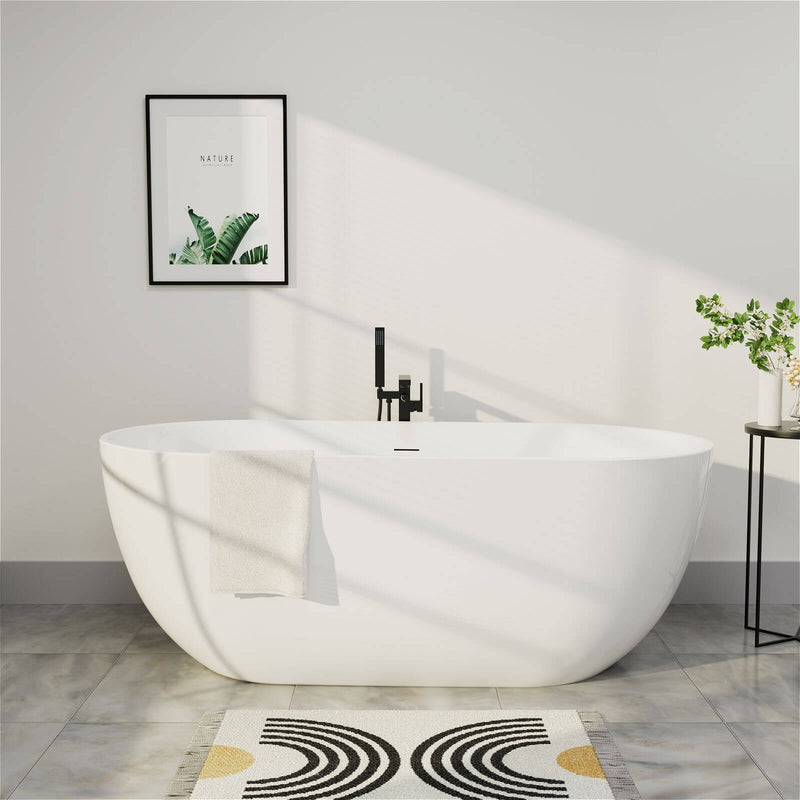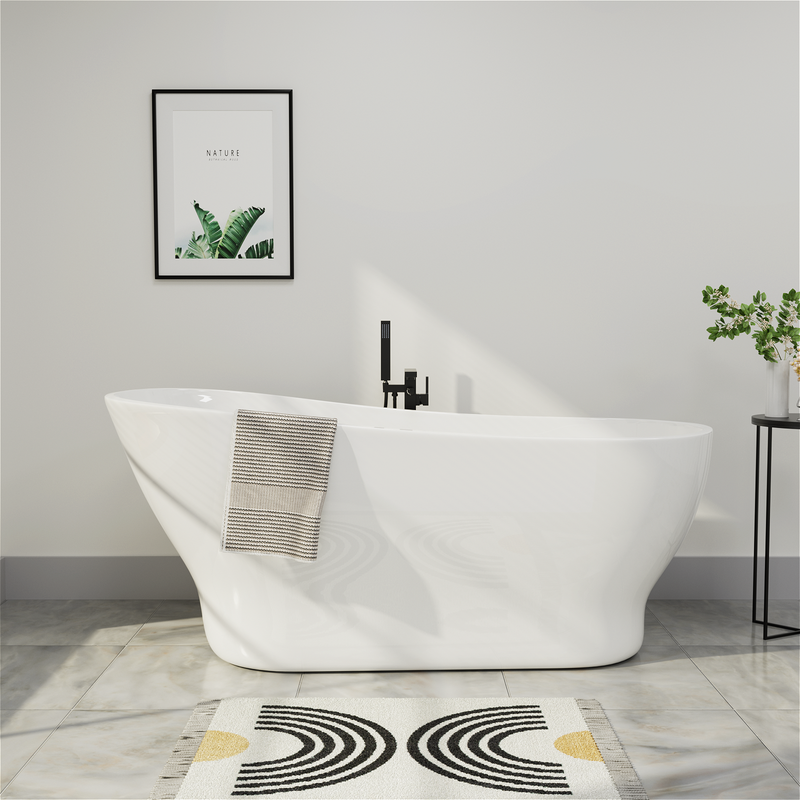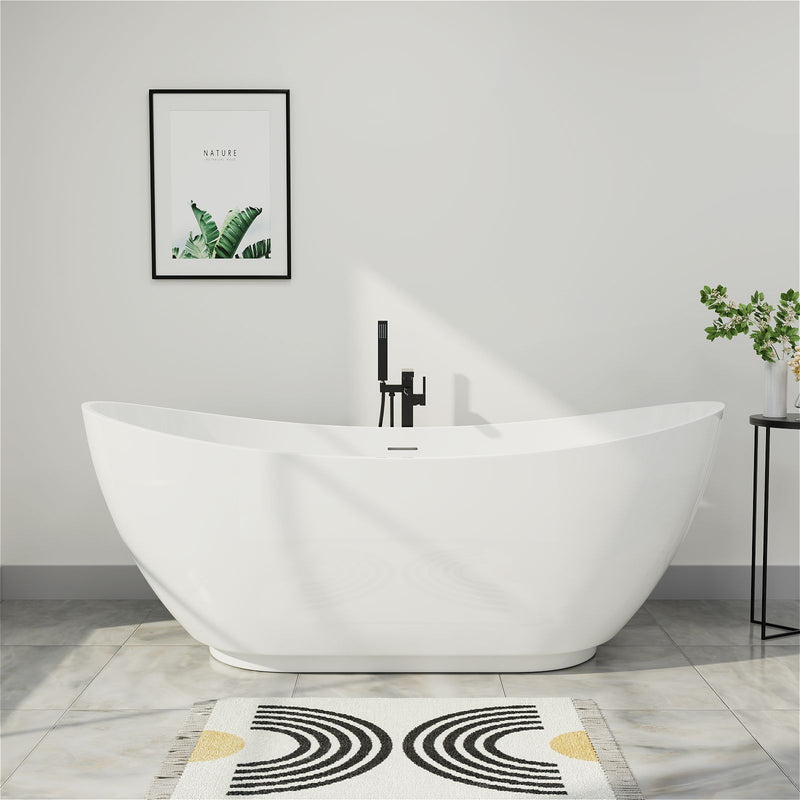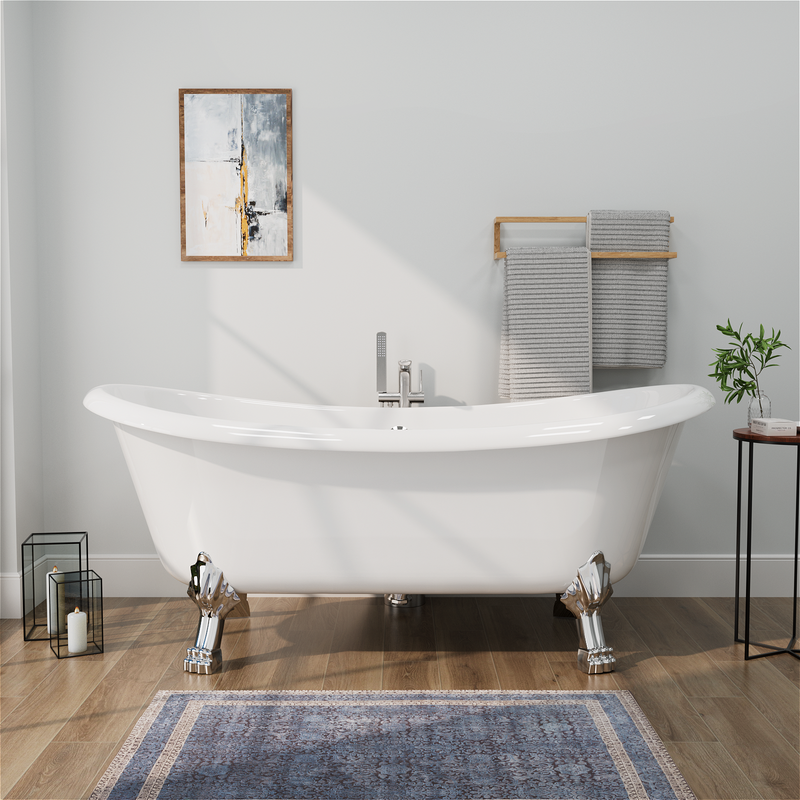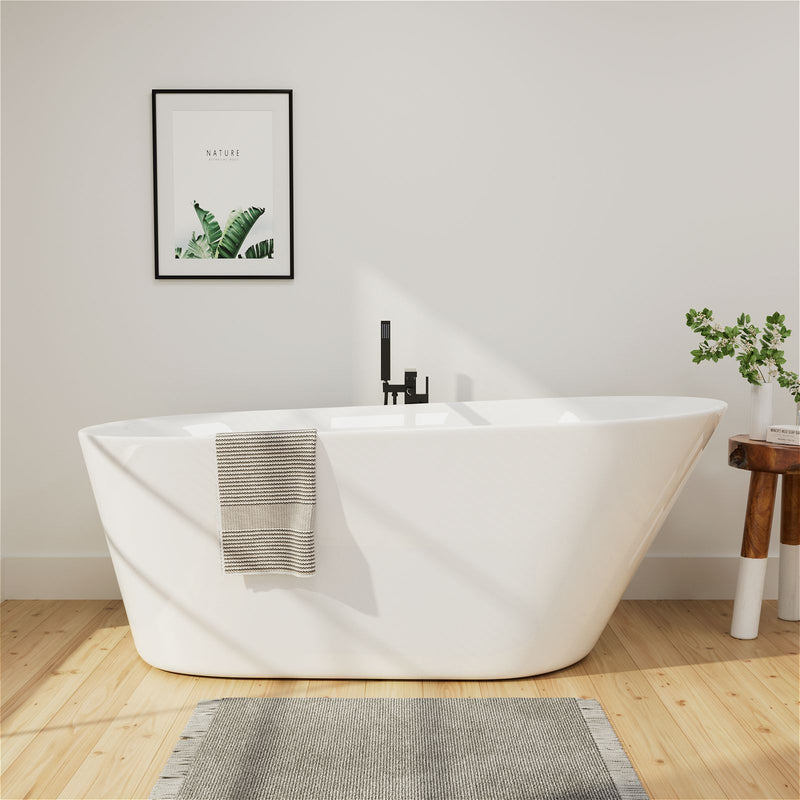Black bathtubs are no longer niche or strictly Victorian-inspired pieces. In the past decade, they have moved from rare statement fixtures into mainstream bathroom design. Homeowners and designers pick black tubs for many reasons: bold visual impact, easier color coordination with dark hardware and tile, new finish technologies, and an ability to function in both minimalist and contrasted interiors. But a black tub also brings practical considerations—material choices, maintenance, lighting, safety, resale, and installation—that matter as much as aesthetics.
Aesthetics and Visual Impact
Why Black Reads as Sophisticated
Black creates instant visual weight. When used as a bathtub color, it becomes a focal point. In neutral or light-toned bathrooms, a black tub anchors the space and gives the room a clear focal element that contrasts with pale tiles or painted walls. The contrast draws the eye and can make other finishes—brass, nickel, matte black faucets—read as deliberate design choices rather than afterthoughts.

A black tub can work with multiple styles. In contemporary bathrooms, a matte black freestanding tub pairs well with clean lines and minimal hardware. In transitional or industrial designs, a glossy black tub with metal feet or exposed plumbing can add drama. In smaller spaces, a dark tub can act like a piece of furniture—a sculptural object that elevates a compact bathroom.
How Black Affects Perceived Size and Mood
Dark colors tend to make surfaces recede visually, a black bathtub may make the tub itself feel more integrated with the floor or surround when the surrounding palette is dark. In contrast, in a very small, light bathroom, a black tub reads as a deliberate design contrast that can actually make the space look more curated rather than smaller—provided proportions, lighting, and layout are handled correctly.
Black also changes the mood. It gives a room a calm, spa-like, or dramatic quality depending on finish and lighting. Matte finishes feel more modern and muted, glossy finishes feel more formal and reflective. Choosing black is not only about color but about what finish and surrounding elements you pair it with.
Practical Advantages (Beyond Looks)
Flexible Coordination with Fixtures and Tile
One practical plus of black is how well it coordinates with other finishes. Dark tubs match matte black faucets and fixtures naturally, they also complement bronze, brushed brass, and even polished chrome, creating either tonal harmony or deliberate contrast. If your renovation includes dark hardware, a black tub ties that palette together and makes the hardware selection feel cohesive.
Concealing Certain Types of Wear
A black bathtub can conceal some visual imperfections that show more readily on white tubs—such as slight discoloration in acrylic due to age or minor staining where the finish is not glossy. That said, not all imperfections disappear: mineral deposits, soap scum with white residue, and light scratches can be more visible on dark finishes if the finish is glossy. The key is choosing the right finish (matte vs gloss) and maintenance routine.
Design Longevity
Because black is a neutral that reads as contemporary and classic at once, it can have long design staying power. A well-chosen black tub can age more gracefully than a very trendy color and can support a range of design changes—tile, vanity, and paint—without needing replacement.
Material Choices and Heat Retention
Common Bathtub Materials
When choosing a black bathtub, you're choosing a materialand a finish. Common materials include:

- Acrylic (reinforced acrylic shells) — lightweight, easier to install, wide range of color and finish options. Acrylic warms to the touch faster than metal but loses heat faster than cast iron.
- Cast iron with enamel — heavier, excellent heat retention, very durable. Cast iron classic tubs are typically enamel-coated and can be finished black.
- Solid surface / composite stone — denser than acrylic, good heat retention, can be produced in matte finishes. Often used for contemporary freestanding bathtubs.
- Copper or metal — premium option, excellent heat retention and unique patina characteristics, black metal finishes are possible but typically cost more.
How Material Affects the Black Finish
Acrylic lends itself to very consistent black coloring and is easier to manufacture in matte or gloss finishes. Cast iron finished in enamel can provide deep, saturated color and exceptional durability—but the tub will be very heavy. Solid-surface tubs can mimic stone and provide a velvety matte black that resists fingerprints better than a glossy finish.
Heat retention is an important functional factor. For long soaks, cast iron and solid-surface tubs stay warm longer than acrylic. If keeping bathwater hot for extended periods matters to you, consider material choice first and color second.
Finish Options: Matte vs Gloss vs Textured
Gloss Finishes
Gloss reflects light and reads as more formal. Glossy black highlights curves and silhouettes and can make the tub feel like a classic focal piece. The downside is that gloss shows water spots, soap scum residue, and fine scratches more readily, it also requires more frequent wiping if perfect appearance matters.
Matte Finishes
Matte black is popular because it hides small water spots and light fingerprints and offers a subdued, contemporary aesthetic. Matte surfaces are generally more forgiving for everyday use. However, matte finishes can be harder to restore if stained with strong chemicals or oils, so avoid abrasive or solvent cleaners.
Textured and Soft-Touch Finishes
Some solid-surface and composite tubs provide a barely textured or soft-touch surface that feels warm and tactile. These finishes combine a modern look with practical wear resistance and a lower maintenance profile. They are often more expensive than acrylic but provide a premium experience.
Maintenance and Cleaning
General Cleaning Rules for Black Tubs
Use mild, pH-neutral cleaners, avoid bleach or high-alkaline cleaners that can degrade color or finishes.

Use soft cloths or non-abrasive sponges. Abrasive pads can cause micro-scratches that are more visible on dark finishes.
Rinse surfaces thoroughly after cleaning to prevent residue build-up.
For matte finishes, avoid wax-based polishes that can change the surface sheen.
Specific Concerns
- Mineral deposits: hard water leaves white mineral deposits that are visible on black surfaces. Use a vinegar-based solution (diluted) or a recommended hard-water cleaner sparingly, and rinse well.
- Soap scum: appears as a white film on dark tubs, routine rinsing and occasional targeted cleaning prevent buildup.
- Scratch repair: shallow scratches on acrylic can sometimes be buffed lightly with a polishing compound recommended for that material. Deeper damage on enamel or solid-surface may require professional repair.
Practical Maintenance Schedule
- Daily/After use: quick rinse and wipe with soft cloth to remove soap residue.
- Weekly: gentle cleaner with soft sponge, focus on drain area and seams.
- Quarterly: inspect feet, supports, and seals, check caulking and floor under and around the tub for any signs of moisture.
Lighting, Color Balance, and Layout Considerations
Lighting is Essential
Dark fixtures need good lighting to read well. A black bathtub in a dim bathroom can look heavy and closed-in. Counterbalance dark fixtures with layered lighting: general overhead, task lighting near mirrors, and accent lighting that highlights the tub from above or behind. Natural light is especially useful, place the tub near a window when layout allows, but be mindful of privacy.
Tile and Wall Colors
Black pairs well with many palettes. Popular combinations include:
- Black tub + white tile for high contrast and a classic look.
- Black tub + warm wood tones to add warmth and soften contrast.
- Black tub + deep greens or navy for a moody, luxurious palette.
- Black tub + neutral stone tile for a contemporary spa effect.
Pay attention to grout color—light grout against dark tiles can create a busy look, matching grout tones or using large format tiles simplifies the visual field.
Floor and Step Considerations
If the tub rim is the same color as the floor, the tub can blend into the floorplane. If you want the tub to stand out, use a contrasting floor color or a small elevated platform. For black tubs, a lighter floor often helps the tub pop visually and reduces the risk of feeling boxed in.
Safety and Accessibility
Slip Resistance
Black is only a color decision—safety depends on surface texture. Make sure the interior bottom has a textured, slip-resistant finish or add adhesive non-slip pads. This is particularly important if you have elderly users or children.
Entry and Exit
If the black tub has higher rims, steps, or platforms may be necessary. Consider grab bars in complementary finishes (matte black or brushed metal) that match the tub's hardware and provide safety without disrupting aesthetics.
Visibility for Household Members
In households with very low lighting or vision impairment, a black tub may be less visible. Use lighting near steps and edges and choose contrasting floor tiles to clearly delineate the tub area.
Installation and Structural Considerations
Weight and Subfloor
As with any bathtub, the material determines loading. Cast iron tubs are heavy and often require floor reinforcement, especially on upper stories. Acrylic and composite tubs are much lighter and easier to install in second-floor bathrooms without structural changes.

Plumbing and Drain Placement
Decide whether your tub will be freestanding, built-in, or installed on a platform. Freestanding black tubs allow flexible placement but may require exposed plumbing accents that you will want to match to the tub finish. Center drains vs. end drains affect plumbing routing, consult a licensed plumber when planning.
Delivery and Doorway Clearance
Because of the tub's color, many people choose a freestanding shape, which can be heavy or awkward to carry. Measure doorways, stair turns, and hall widths in advance. Black tubs made of composite or acrylic may be sectional or lighter, simplifying delivery.
Resale and Market Considerations
How Buyers View Dark Fixtures
Black tubs are a deliberate design choice, while many buyers and designers view them as a premium feature, not everyone prefers them. If resale value is a concern, think about how a black tub fits the overall home aesthetic. In high-end urban markets where bold design is common, a black tub can be a selling point. In conservative or entry-level markets, a black fixture may be polarizing.
Mitigating Resale Risk
If resale is a priority but you want to keep a black tub, choose a classic tub shape (rolled rim or slipper) in a material trusted for longevity (cast iron or quality composite). Neutral surrounding finishes and a reversible installation (where possible) reduce perceived risk for future buyers.
Cost Considerations
Price Range by Material and Finish
- Acrylic black tubs: typically most affordable, wide style range.
- Composite/solid surface: mid to high, premium matte finishes.
- Cast iron enamel black: higher cost due to materials and installation complexity.
- Copper/metal: highest cost, specialty finishes.
Custom colors, special feet, or integrated features (heating, lighting) increase costs. Factor in delivery, any floor reinforcement, plumbing changes, and professional installation.
Long-Term Value
Investing in a higher-quality material can save money over time by reducing repair or replacement needs and preserving appearance. Solid finish warranties and reputable manufacturing practices are worth evaluating.
FAQs
Q: Will a black bathtub make my small bathroom look even smaller?
A: Not necessarily. While black absorbs light, you can counteract any shrinking effect by using a light color palette for walls and floors, incorporating ample lighting, and using large mirrors to reflect light and create an illusion of space. A single black tub as a focal point can actually add depth to a small room.
Q: Is a black bathtub harder to keep clean?
A: It depends. Soap scum and water spots can be more visible on black surfaces, particularly glossy ones, compared to white tubs. However, modern finishes on quality tubs are designed to be low-maintenance and resist staining. Regular wiping and using gentle cleaners can easily keep it looking pristine.
Q: Is a black bathtub a passing trend?
A: No. Black has proven to be a timeless color in interior design. Its surge in popularity in bathrooms reflects a move towards more personalized and dramatic home spaces. As a neutral, black is a classic that has been used in design for centuries and is unlikely to go out of style.
Q: What bathroom styles does a black bathtub work with?
A: A black bathtub is remarkably versatile. It fits perfectly into modern, minimalist, industrial, and mid-century modern styles. It can also be used to create a dramatic, classic look in traditional or Victorian-style bathrooms when paired with ornate fixtures and rich materials.
Q: Can I install a black bathtub in an existing bathroom without a full remodel?
A: Yes. If you are replacing an existing freestanding tub, it can be a straightforward swap if the plumbing connections are compatible. For built-in models, it may require more work. The key is to ensure the new black tub complements your existing tiles, vanity, and color scheme.
Q: Will a black bathtub show soap scum and water spots more than a white tub?
A: It depends on finish. Glossy black shows mineral deposits and soap scum in white contrast more clearly, while matte black hides light spots better. Regular rinsing and the right cleaners prevent most visibility issues.
Q: What faucets and hardware pair best with a black tub?
A: Matte black creates a monochrome look. Brushed brass or brushed nickel provide elegant contrast. Polished chrome adds brightness. Match the level of formality—polished finishes for traditional, matte/brushed for modern.
Q: Does a black tub affect bathroom lighting needs?
A: Yes. Dark fixtures need good ambient and task lighting to avoid a heavy or closed-in feel. Plan layered lighting and consider accent lights near the tub.
Q: How do I repair scratches on a black acrylic tub?
A: Minor scratches can often be polished out with a manufacturer-recommended acrylic polish or rubbing compound. Deeper damage may require professional repair or refinishing.
Q: Is a matte black finish durable?
A: Modern matte finishes are designed for everyday use, but they can show oily residue if improperly cleaned. Use cleaners recommended by the manufacturer and avoid polishes or waxes that alter sheen.
Conclusion
Choosing a black bathtub is both an aesthetic and practical decision. A black tub can create a strong visual anchor, coordinate smoothly with modern hardware, and offer a durable, design-forward focal point. But it isn't purely decorative: the material you select, the finish (matte vs gloss), lighting and maintenance routines, and installation logistics all matter. For many homeowners, the best route is to balance style with function—choose a material that meets your heat-retention and weight requirements, pick a finish that fits your cleaning tolerance, and plan lighting to highlight the tub without darkening the room.
If you're considering a black bathtub for your home, evaluate the room's size and natural light, decide which material matches your lifestyle, and work with a supplier or installer who can confirm structural requirements and provide finish-specific care instructions. When executed correctly, a black bathtub can turn a bathroom into a sophisticated, modern, and highly usable space.

